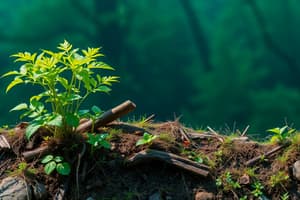Podcast
Questions and Answers
What defines carrying capacity in an ecosystem?
What defines carrying capacity in an ecosystem?
- The total area occupied by a population
- The speed at which a population grows
- The number of resources available for a population
- The maximum number of individuals an environment can support (correct)
What is a common consequence of a trophic cascade?
What is a common consequence of a trophic cascade?
- Reestablishment of the original ecosystem state
- Immediate increase in biodiversity
- Reduction in all types of species
- Loss of a keystone species (correct)
Which of the following best describes invasive species?
Which of the following best describes invasive species?
- Species that are native and beneficial to an ecosystem
- Organisms that adapt quickly to new environments
- Non-native species that disrupt the local ecosystem (correct)
- Endangered species that require conservation
Which of the following is a limiting factor that can affect population growth?
Which of the following is a limiting factor that can affect population growth?
What role do bacteria play in the nitrogen cycle?
What role do bacteria play in the nitrogen cycle?
Which of the following is NOT a method by which carbon dioxide is released into the atmosphere?
Which of the following is NOT a method by which carbon dioxide is released into the atmosphere?
What is the primary way that plants utilize carbon dioxide?
What is the primary way that plants utilize carbon dioxide?
How does the predator-prey relationship generally function in an ecosystem?
How does the predator-prey relationship generally function in an ecosystem?
Flashcards
Keystone species
Keystone species
A species that has a large impact on the ecosystem, and its removal can cause significant changes in the community.
Trophic Cascade
Trophic Cascade
The change in an ecosystem's structure and function caused by the removal of a keystone species.
Carrying Capacity
Carrying Capacity
The maximum number of individuals an environment can support sustainably.
Nitrogen Fixation
Nitrogen Fixation
Signup and view all the flashcards
Denitrification
Denitrification
Signup and view all the flashcards
Limiting Factors
Limiting Factors
Signup and view all the flashcards
Invasive Species
Invasive Species
Signup and view all the flashcards
Invasive species
Invasive species
Signup and view all the flashcards
Study Notes
Population Growth
- Population increases due to immigration, abundant food/space/resources, and fewer predators.
- An invasive species is a non-native species that causes ecological problems.
- Carrying capacity is the maximum number of individuals an environment can support.
- Carrying capacity is reached in phase III of a population growth graph.
- Limiting factors include predation, emigration, competition, natural disasters, and human activity.
Predator-Prey Relationship
- If the predator population increases, the prey population decreases.
- Conversely, if the prey population increases, the predator population increases.
Keystone Species
- A keystone species is a species that the entire ecosystem depends on.
- Examples include the sea otter and Yellowstone gray wolf.
Trophic Cascade
- A trophic cascade occurs when a keystone species is removed.
- This dramatic change affects the entire ecosystem.
- For example, when the gray wolf was removed, the elk population increased, and the plant population decreased significantly.
Carbon Cycle
- Four ways carbon dioxide is released into the atmosphere: respiration, decomposition, volcanic eruptions, and burning of fossil fuels.
- Carbon dioxide is used primarily in photosynthesis.
- High levels of carbon dioxide cause the greenhouse effect, leading to global warming.
Nitrogen Cycle
- Only bacteria convert nitrogen gas into usable nitrogen compounds.
- Nitrogen is essential for creating proteins.
- Free nitrogen in the atmosphere is converted into nitrates and other usable forms by bacteria in soil and water.
- These compounds are then used by plants, and then animals.
- Denitrification converts nitrogen compounds back into nitrogen gas.
Phosphorus Cycle
- Erosion and weathering of rocks and minerals release phosphorus into soil.
- The phosphorus cycle does not involve a gaseous phase.
Studying That Suits You
Use AI to generate personalized quizzes and flashcards to suit your learning preferences.




